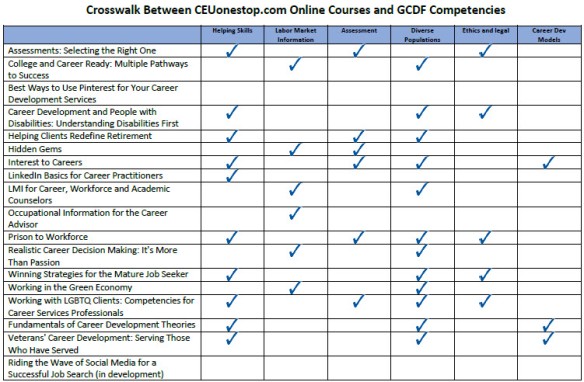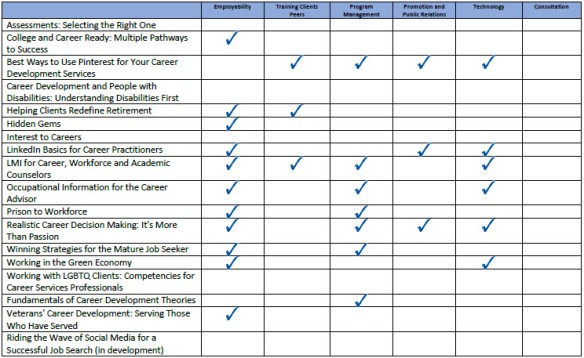 Military Enlistment and the Importance of the ASVAB for Military and Civilian Work by Janet E. Wall
Military Enlistment and the Importance of the ASVAB for Military and Civilian Work by Janet E. Wall
(original published in the Career Development Network Journal, Winter 2017-8)
At the outset it is important to understand that there are two major classifications of military personnel – officer and enlisted. Commissioned officers are generally required to have a bachelor’s degree and can apply for military through a variety of channels including the service academies and Reserve Officers’ Training Corps (ROTC). Some have a Master’s degree or higher. They are the managers of large units of military personnel and also serve as staff advisors.
Enlisted military are not required to have a bachelor’s degree and must apply to be accepted. They do the hands-on work in the military and also take on significant leadership responsibilities. To become an enlisted member of the Armed Forces, an individual must meet certain requirements. The purpose of this article is to help you understand what it takes to be an enlisted person in the military and the relationship of those qualifications to civilian careers.
The Myth About Serving in the Military
There is still a myth that if you get in trouble your options are go to jail or go into the military, the presumption being that many troubled and unworthy are “sentenced” to military service. This presumption persists despite the fact that it is patently false. It is important to know that, unlike some institutions, there is no open admissions policy allowing anyone who wants to join the military to do so. It is a privilege – not a right, and many military applicants don’t make the cut.
Pentagon Congressional testimony reported that 75 percent of young Americans had problems preventing them from being considered for military service. Individuals who wish to join the military must demonstrate specific physical abilities, lack serious criminal records, and most must be high school graduates. In addition, they need to meet specific academic standards as measured by a multi-aptitude test battery called the Armed Services Vocational Aptitude Battery (ASVAB). This article focuses primarily on the ASVAB, but also discusses other education requirements and behavior lifestyle issues.
The Aptitude Hurdle – Success on the ASVAB
About 180,000 people join the military each year. The military is the largest employer of high school graduates in the nation, and it is also very concerned about the education level and aptitude of applicants who wish to join. One important requirement is to score at an acceptable level on the Armed Services Vocation Aptitude Battery, the ASVAB. You can think of the ASVAB as the entrance exam with cut scores that qualify or deny entrance.
The ASVAB is a battery of individual tests used for civilian career exploration as well as enlistment into the military services. It is made up of the tests listed below. Each test measures knowledge and skills important for military entrance and/or acceptance into training programs for certain military jobs. The test has about 200 items and takes more than two hours to complete. There is a minimum score to qualify for military service; other scores or score combinations offer a person access to certain occupations (called Military Occupational Specialties or MOSs).
The ASVAB Subtests
Subtest Description
General Science Measures knowledge of physical and biological sciences
Arithmetic Reasoning Measures ability to solve arithmetic word problems
Word Knowledge Measures ability to select the correct meaning of words presented in context, and identify synonyms
Paragraph Comprehension Measures ability to obtain information from written material
Mathematics Knowledge Measures knowledge of high school mathematics principles
Electronics Information Tests knowledge of electricity and electronics
Auto Information Measures knowledge of automobiles, tools, and shop terminology and practices
Shop Information Measures knowledge of shop terminology and practices
Mechanical Comprehension Measures knowledge of mechanical and physical principles, and ability to visualize how illustrated objects work
Assembling Objects Measures the ability to interpret diagrams showing special relationships and how objects are related and connected
To even be considered for enlistment into the military, an applicant needs to perform especially well on four of the ASVAB tests; in combination, these are called the Armed Forces Qualification Test – the AFQT. The AFQT is a combination of the Math Knowledge, Arithmetic Reasoning, Word Knowledge, and Paragraph Comprehension tests.
Why these 4 tests? Countless studies by both military and civilian researchers have shown that math and verbal capability taken together are a strong and significant predictor of training success and job performance. Math and verbal capability, sometimes called general mental ability, have been shown in multiple studies to predict how well a person will perform on the job and to succeed in their career progression.
The AFQT is calculated by combining a person’s scores on Word Knowledge and Paragraph Comprehension into a composite called Verbal Ability (VE) and adding to it a person’s scores for Math Knowledge (MK), and Arithmetic Reasoning (AR). The formal equation is AFQT=2VE+MK+AR. That score then is compared to the scores of a nationally representative sample of youth – the norm group. The norm group was a carefully selected representative sample of youth 18-24 in a noteworthy and painstaking national study.
Scores are reported as a percentile. The percentile indicates how well a person ranks in comparison to the norm group of comparable youth. The percentile distribution is further divided into AFQT categories as shown below.
Armed Forces Qualification Test (AFQT) Categories and Corresponding Percentile Score Ranges
AFQT Category Percentile Score Range
I 93-99
II 65-92
IIIA 50-64
IIIB 31-49
IV 10-30
V 1-9
Recruiters and the Department of Defense prefer enlisting persons in the highest AFQT categories because they are generally mentally and academically sharper, resulting in greater success in training programs related to the various occupations needed by the military. It is also cheaper for the Department of Defense to recruit smarter individuals because they learn much quicker and perform better on the job. This is not unlike civilian employability.
Persons in Categories I and II are considered above average in trainability. Category III recruits are considered to be average in trainability, and Category IV recruits are below average. Applicants scoring in Category V are forbidden by law to be accepted into the military. Military applicants in Category IV that do not have a high school diploma are generally refused admission into the military. This is because there is ample research to show that people without a high school diploma fail to complete their training and attrit at higher levels than those with a high school diploma. Given the cost of training, it is sensible for the federal government to want to train people who are more likely to succeed.
In addition to the Services desiring to enlist higher ability recruits, those with higher scores have more advantages. High scores are associated with enlistment bonuses. High scoring recruits also have access to more training and job options leading to more control in selecting their occupational field. They also have access to training and job experience in highly technical fields. Many experience faster promotions along with more responsibility. High scores make for an attractive recruit and successful soldier, sailor, marine and airman.
ASVAB and Civilian Careers
Since there is about an 88 percent crosswalk between military and civilian occupations, high scores can also set individuals on a successful career path after their enlistments have been completed. That and the training, job experience, and level of responsibility make military veterans attractive to civilian employers.
High ASVAB scorers also showed a distinct pay advantage in civilian jobs and careers. The difference was not so noticeable at ages 19, 20, and 21; but by age 22, top ASVAB scorers were earning more than those who scored lower. This trend continued through age 31 when the study, called the National Longitudinal Study of Youth, was terminated.
By age 31, the pay difference was substantial. For example, persons who scored in the top 25% on the ASVAB Paragraph Comprehension test earned about 1.5 times as much as those who scored in the bottom 25%. On the Mathematics tests, those in the top 25% of ASVAB scorers were earning about 1.75 times as much as those who scored in the bottom 25%. On the ASVAB General Science test, the results were about the same. Although data were not collected beyond age 31, it is likely that high ASVAB scorers continued to earn more than low scorers throughout their careers.
People have speculated as to why this pay differential occurs. Some say that persons with the high scores had more training opportunities, which ultimately led to better and higher paying jobs. Others say that the more academic knowledge that you have, the more capable you are at excelling on the job and being rewarded financially, eventually obtaining better and higher paying jobs. Regardless of the explanation, high scores on the ASVAB translate to better opportunities and pay in both the military and civilian worlds. Some research finding can be found here. http://nces.ed.gov/pubs97/web/97939.asp
The ASVAB, Job Training, and the MOS
After the applicant shows that he or she has achieved at least the minimum cut score on the AFQT, the next step is to determine which occupational field may be suitable. This step is called classification. The purpose is to determine which jobs and job training may be most suitable for each individual. Basically it is a matching process.
The four AFQT tests and the other ASVAB tests are used in various combinations to determine what job field or Military Occupational Specialty (MOS) is best for the individual. The military services have conducted, and continue to conduct, research to identify the optimal combination of ASVAB tests that are most highly correlated with successful on-the-job performance for clusters of occupations. The exact combinations for each of the services and the ASVAB scores used can be found in more detail at http://official-asvab.com/military_res.htm
For example, each of these clusters has a minimum score that must be obtained in order to enter a technical field versus an administrative field. Persons who have high ASVAB scores have more jobs or MOSs available to them, and they very often can select which of the fields they prefer, within the parameters of the needs of each Service.
Educational Credentials – Further Requirements
The amount of education a person has obtained prior to enlistment matters for eligibility to enter military service. The Department of Defense uses a three-tier classification of education credentials. The three tiers are:
Tier 1—Regular high school graduates, adult diploma holders, and non-graduates with at least 15 hours of college credit.
Tier 2—Alternative credential holders, including those with a General Education Development (GED) certificate of high school equivalency.
Tier 3—Those with no high school education credential.
The reason for adoption of this classification system of educational credentials is because of the strong relationship between education credentials and successful completion of the first term of military service. That is, with an acceptable AFQT score and educational credentials, a person is more likely to complete his or her term of enlistment. This is precisely why civilian employers prefer high school graduates over those without the diploma.
The Services are required by law to ensure that a minimum of 90 percent of first-time recruits are high school diploma graduates. Services often set even higher standards and try to achieve education goals that are higher than the minimum requirement, often reaching near 100 percent high school graduates in their enlistment pool. For applicants without a traditional high school diploma, the individual’s AFQT score will need to be higher.
Services are required to enlist at least 60 percent of recruits from AFQT Categories I-IIIA. There are different standards for individuals in each tier. Generally, Tier 3 applicants must have higher AFQT test scores than Tier 2 applicants, who must have higher test scores than Tier 1 individuals.
The chart below shows the percentage of active duty enlisted personnel accessed in 2014 and civilians by AFQT category, the latest available data. As can be seen, the military enlists more than the 60% requirement of individuals above the 50th percentile and hat there are more people above the 50th percentile in the military as compared to equivalent aged civilians.
Percent by AFQT Category of Enlisted Military as
Compared to the Same Age Civilians
AFQT I AFQT II AFQT IIIA AFQT IIIB IV TOTAL I+II+IIIA
DoD
Enlisted 5.7 34 25.1 23.7 9.6 100 64.8
US Civilians 7.9 27.7 15.5 18.8 20.7* 100 51.1
*Includes CAT V which are not allowed to join the military
This next chart shows the education credentials of active duty enlisted personnel accessed in 2014 and civilians by education tier.
Percent by Educational Tier of Enlisted Military
as Compared to the Same Age Civilians
Tier 1 Tier 2 Tier 3 TOTAL
DoD Enlisted 96.9 3.1 .02 100
US Civilians 85.0 + 15 100
+Civilian data combine Tiers 1 and 2
The US civilian data in both charts highlight the characteristics of the military applicant pool or potential recruits. The DoD data reflect those who are actually accepted into military service. It is easy to see that the Armed Forces enlist individuals with superior average aptitude and educational credentials compared to the civilians of the same age group. Any applicants for military service who don’t meet the requirements are rejected and have to find work in the civilian sector. The full report of military officer and enlisted demographics can be found here. https://www.cna.org/poprep/2014/contents/contents.html
Behavior and Life Style Issues
There are many other disqualifying criteria for military applicants. Drug use, criminal records, financial difficulty, physical fitness, and health issues can prevent a person from being accepted into the military. Some conditions are waverable, but most are not.
Among the disqualifying conditions are:
- Drug or alcohol dependency, use, or involvement
- Mental illness that cannot be easily treated
- Physical conditions such as dental, ears and hearing, blood disorders, eyes and vision, etc
- Criminal history which has resulted in a conviction
- Deviant sexual behavior
- Minimum and maximum height requirements
- Obesity
- Poor physical fitness
- Significant financial debt that would be exacerbated during service
For a detailed list of medical conditions, see this resource http://www.military.com/join-armed-forces/disqualifiers-medical-conditions.html.
Dwindling Applicant Pool and National Security Concerns
In its paper, Ready, Willing, and Unable to Fight, Mission Readiness, a group with more than 600 flag rank officer members, concluded that 25-27 percent of youth are unable to serve in the military due to being overweight, 10 percent cannot join because they have at least one prior conviction for a felony or serious misdemeanor, and 32 percent have health problems not related to weight such as asthma, physical and mental issues, or treatment for Attention Deficit Hyperactivity Disorder. An additional number have educational issues (ASVAB and high school diploma) resulting in the total of about 75 percent of age eligible youth are NOT QUALIFIED to serve in military uniform. The report can be found here. https://strongnation.s3.amazonaws.com/documents/3/ad129721-81c2-430e-a0a9-72611ec2ad1c.pdf?1469801577
The Education Trust developed a report, Shut Out of the Military: Today’s High School Education Doesn’t Mean You’re Ready for Today’s Army (http://edtrust.org/wp-content/uploads/2013/10/ASVAB_4.pdf), bemoaning the fact that because of educational deficiencies in our schools, many young people will be denied a chance at good jobs and careers in the military where they can get good training and job experience. The report suggests that since the ASVAB also measures occupational skills and aptitudes pertinent to civilian jobs, they may also lack the qualifications for a good job in the civilian world-of-work.
The report also provides evidence from a study that reported military ineligibility by state showing that states like Hawaii, Mississippi, Washington DC, Louisiana, and South Carolina had the highest ineligibility – well above the national average. Further, youth of color had far higher ineligibility rates based on education and aptitude than whites. These educational deficiencies do not bode well for our ability to maintain a competent fighting force to protect our national security. It also suggests that we are not providing our youth with the necessary skills to maintain our country’s economic vibrancy and safety.
Conclusion
It is evident that applicants accepted into the military have on average higher intellectual abilities and superior educational credentials than their civilian counterparts. They must also meet specific physical fitness, and behavioral standards. Those who still believe the myth that military service is for those who have no other job options are clearly misguided. Because they have chosen to protect our national security, they are an elite group that represent the best in America.
 Janet is the former manager of the ASVAB Career Exploration Program for the US Department of Defense. She is also the author of four ASVAB Test Preparation books published by McGraw-Hill. She is a National Career Development Association Fellow and Founder of CEUonestop.com, an NBCC approved continuing education provider. She can be contacted by email at careerfacilitator@janetwall.net.
Janet is the former manager of the ASVAB Career Exploration Program for the US Department of Defense. She is also the author of four ASVAB Test Preparation books published by McGraw-Hill. She is a National Career Development Association Fellow and Founder of CEUonestop.com, an NBCC approved continuing education provider. She can be contacted by email at careerfacilitator@janetwall.net.



